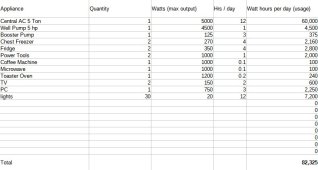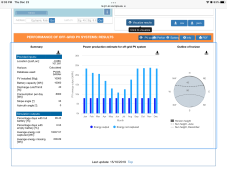Hi all, I've been a fan of will's channel for a while now and I think I'm finally ready to start planning my solar system, but I have a questions around feasibility that I hope someone could help me answer.
A little background first: I live in Indonesia, so we get plenty of sun. But during the rainy season we obviously less. I can't exactly say how much less but it is pretty rare that we have a full day or two of rain. It comes and goes pretty quick. That being said, the contractors in Indonesia I've been in touch with use the following equipment:
- batteries: http://www.pylontech.com.cn/ or https://www.todoensolar.com/Pylontech-lithium-battery-48V-35kw-/-h-US3000s
- Inverter, monitoring system etc: https://www.victronenergy.com/
- Panels: (not sure yet)
The primary purpose of this system is to be able to power a central AC unit that will cool the entire house all the time. I'm assuming we will install a 5 ton unit (60,000 BTU I think) along with everything else. I've made a short of list of my power needs (see image) but there might be additional items so it would be best to oversize the system. I think it's safe to assume I'll need a 86kwh system.

My question is, what is a good assumption in terms of power consumption for the AC unit? I want the unit to run 24/7 but I doubt it will be drawing full power all the time, so how do I go about reasonably estimating the power usage? I'd like the batteries to be able to support 2-3 days of minimal sun, and be able to charge fully in a typical day (is that even possible?).
I plan on tying to the grid (and generator eventually), but only as a backup source of power in case the batteries need topping up or we want to do maintenance on the system. I can sell power back to the government here, but I think they only provide discounts on the normal power usage... It would be impossible to demand a check in the mail for the power I actually sell back
Any and all advice is much appreciated
A little background first: I live in Indonesia, so we get plenty of sun. But during the rainy season we obviously less. I can't exactly say how much less but it is pretty rare that we have a full day or two of rain. It comes and goes pretty quick. That being said, the contractors in Indonesia I've been in touch with use the following equipment:
- batteries: http://www.pylontech.com.cn/ or https://www.todoensolar.com/Pylontech-lithium-battery-48V-35kw-/-h-US3000s
- Inverter, monitoring system etc: https://www.victronenergy.com/
- Panels: (not sure yet)
The primary purpose of this system is to be able to power a central AC unit that will cool the entire house all the time. I'm assuming we will install a 5 ton unit (60,000 BTU I think) along with everything else. I've made a short of list of my power needs (see image) but there might be additional items so it would be best to oversize the system. I think it's safe to assume I'll need a 86kwh system.

My question is, what is a good assumption in terms of power consumption for the AC unit? I want the unit to run 24/7 but I doubt it will be drawing full power all the time, so how do I go about reasonably estimating the power usage? I'd like the batteries to be able to support 2-3 days of minimal sun, and be able to charge fully in a typical day (is that even possible?).
I plan on tying to the grid (and generator eventually), but only as a backup source of power in case the batteries need topping up or we want to do maintenance on the system. I can sell power back to the government here, but I think they only provide discounts on the normal power usage... It would be impossible to demand a check in the mail for the power I actually sell back
Any and all advice is much appreciated



